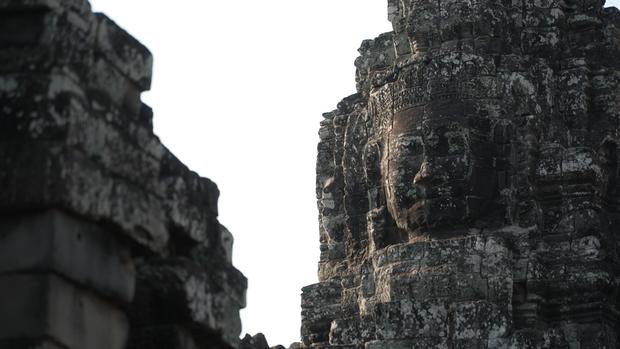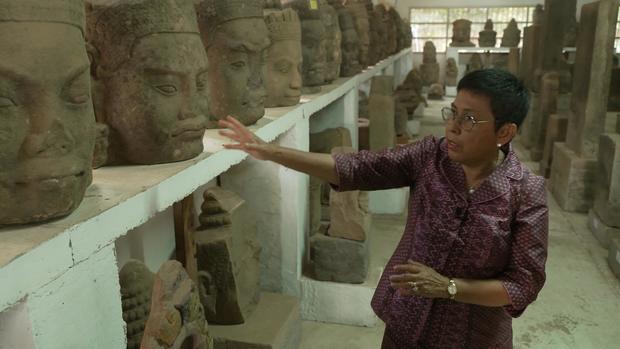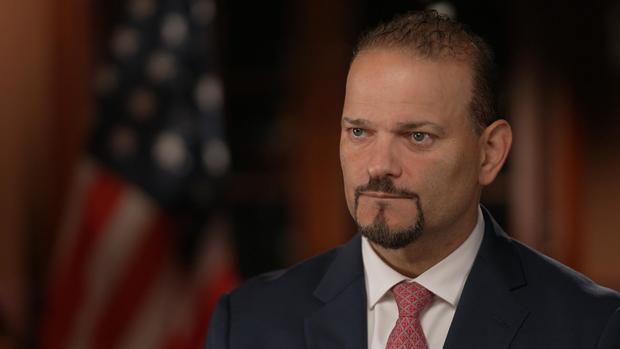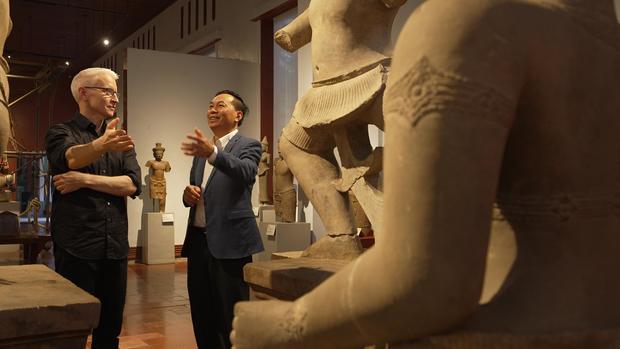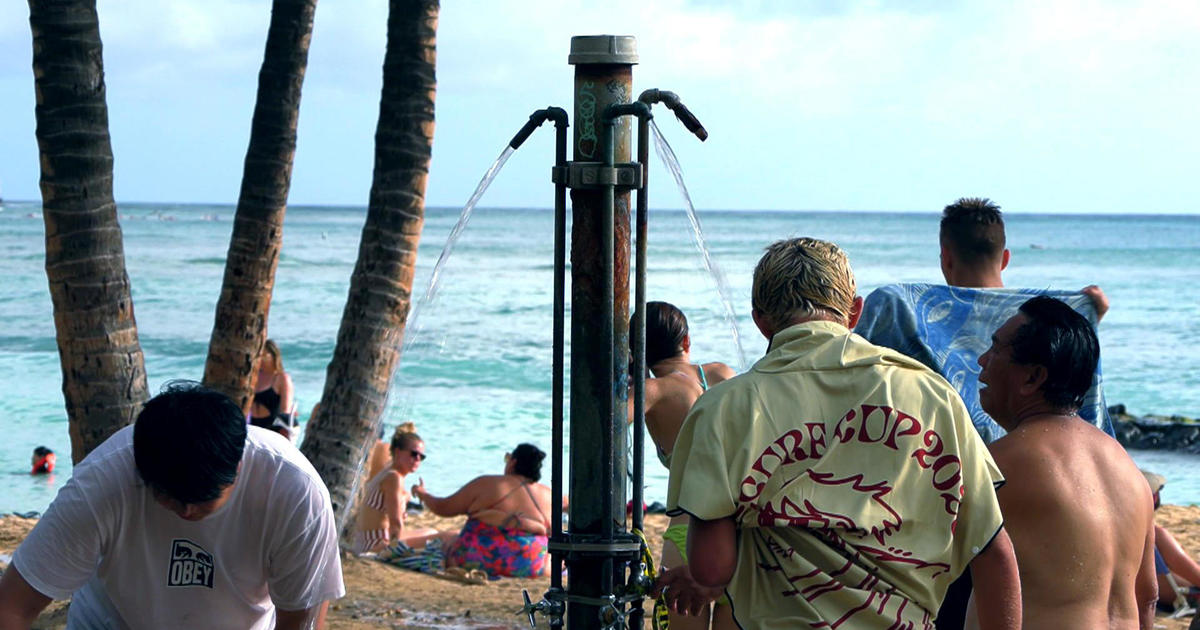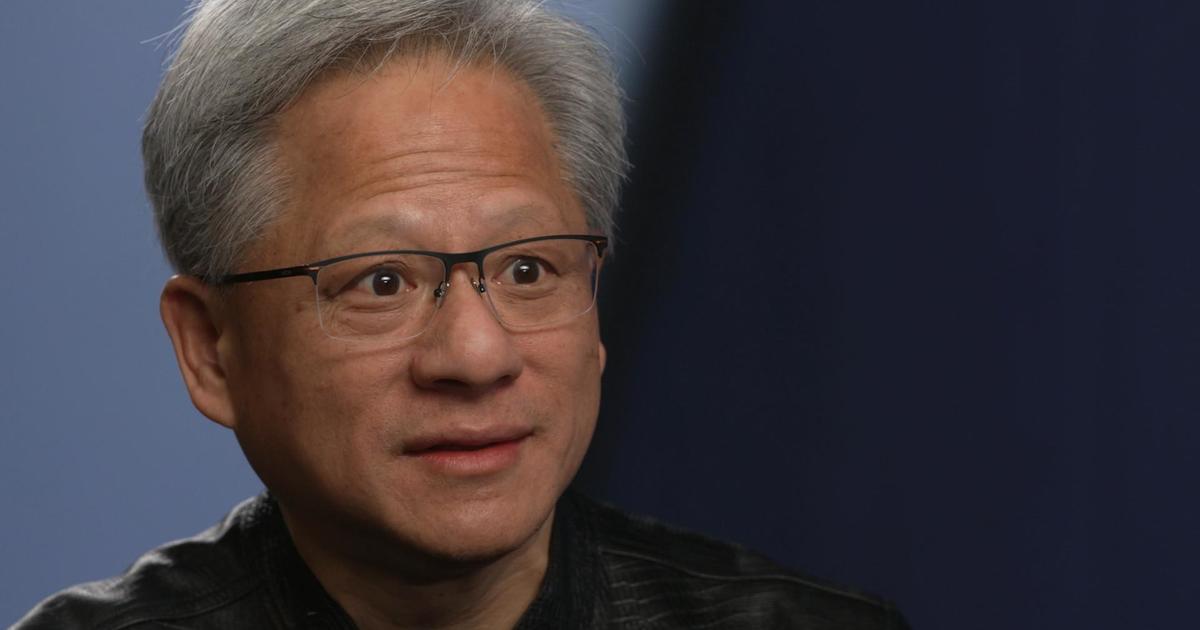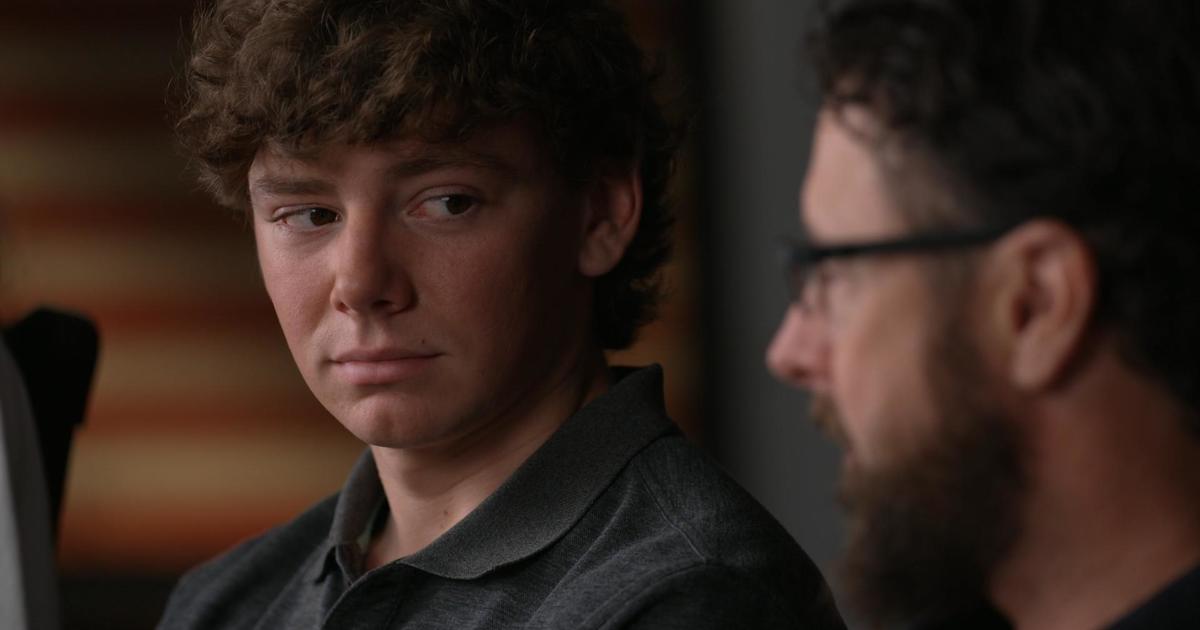How Cambodian artifacts stolen from temples ended up in American museums, private collections
The theft of Cambodia's cultural treasures — thousands of sacred stone, bronze and gold artifacts from religious sites across the country — might just be the greatest art heist in history. It began nearly a century ago when Cambodia was colonized by France, but in the 1970s, 80s and 90s — amidst genocide, civil war, and political turmoil – the looting became a global business, much of it run by a British man named Douglas Latchford. He kept some of it for himself, but much of what his gang of thieves stole, Latchford then sold to wealthy private collectors and some of the most important museums around the world. Cambodia's government has spent the last 10 years trying to track it all down… and now they want their history and heritage brought home.
Angkor Wat, with its towering spires, is the glory of Cambodia. Nearly a thousand years old, it's one of the biggest and most extraordinary religious temples in the world — sprawling across 400 acres. Originally built to honor the Hindu god Vishnu, it then became a Buddhist temple, and remains a place of worship today. You can wander here for weeks, lost in a labyrinth of ancient stone corridors and sacred chambers. But the scars of plunder run deep: looters have hacked off the heads of many statues… they've stolen bodies as well… empty pedestals mark where gods and deities once stood… on some, only the feet remain.
It's worse in the rest of Cambodia's 4,000 temples. Nearly all have been looted. This one is a hundred miles northeast of Angkor Wat… on a remote mountain… called Sandak.
Brad Gordon: This was hit very heavily by the looting gangs.
Brad Gordon: They found gold, they found statues, they found many, many things.
That's Brad Gordon, an American lawyer, who's been working for the Cambodian government for 10 years, tracking down its stolen treasures… he brought us to Sandak with his team of investigators, archeologists and art scholars.
Anderson Cooper: This is so cool.
In the temple's crumbling courtyard, little remains… mostly empty pedestals scattered among the Sralao trees.
Anderson Cooper: It's remarkable to me just how much stuff is just scattered on the ground.
Brad Gordon: Yes.
Brad Gordon: It's like a pedestal graveyard.
Anderson Cooper: We've all seen in museums these statues with no feet on them, and I don't think people realize the feet were hacked off. Because in order to steal them, that's the easiest way to-- to get them off the pedestal.
Brad Gordon: And we know when the looters came to sites like this, the first thing they took was the heads. That was the easiest to grab. And then later on maybe they come back and get the torso. But they were not very careful, so they left behind pieces.
For Cambodians, these statues are not just works of art… they are sacred deities that hold the souls of their ancestors to whom they ask for guidance and pray…
Anderson Cooper: This is incredible. Th-- these were all looted.
Phoeurng Sackona: Yes, all looted.
Anderson Cooper: All of these heads, like, cut off--
Phoeurng Sackona: And the head was cut off, yes.
Phoeurng Sackona, Cambodia's minister of culture, is in charge of the government's efforts to track down their stolen gods. We met her in a closely guarded warehouse not far from Angkor Wat… where more than 6,000 pieces from temples across the country are stored for safekeeping… each one sculpted by an artisan from an ancient Khmer Empire… that lasted for more than five centuries and spanned Cambodia, Laos, Thailand and Vietnam.
Anderson Cooper: So the statues have a soul? The statues are-- are they living?
Phoeurng Sackona: For us, yes.
Phoeurng Sackona: And we believe that we can talk with them. They will hear. They will see. What do you want? What do you see? What do you do in your life, in your house, outside in the society, also? So that--
Anderson Cooper: They're watching.
Phoeurng Sackona: They're watching, everywhere…
Phoeurng Sackona's entire family was killed in the genocide that began in 1975 when the Khmer Rouge, a radical communist group took over, forcing millions of Cambodians into labor camps. Some 2 million people, nearly a quarter of the population, were slaughtered or starved to death. The Khmer Rouge lost power in 1979, but fighting and instability continued for decades, leaving Cambodia's temples unprotected and vulnerable… easy targets for unscrupulous antiquities dealers like Douglas Latchford.
Anderson Cooper: Who was Douglas Latchford?
Brad Gordon: I would say that he was, in many ways, the mastermind behind the greatest art heist in history.
Anderson Cooper: The greatest art heist in history?
Brad Gordon: Yes, in terms of scope and multitude of crime sites and the enormous amount of statues that were taken out.
Latchford lived in Thailand… an enigmatic British businessman… he began collecting in the 1960s. He had, it seems, two great loves: Cambodian antiquities and… Thai bodybuilders… He sponsored Bangkok's biggest bodybuilding competition, the Latchford Classic.
Anderson Cooper: How would you describe him?
Brad Gordon: He was extremely deceptive, I think in many ways, was ruthless. But he hid that behind this incredible façade of charm.
Latchford portrayed himself as a scholar and protector of Cambodia's culture, a reputation he burnished by donating sculptures to the Metropolitan Museum of Art in New York and other prestigious institutions. He also published three books filled with the finest examples of Cambodian antiquities… many of them, it turns out, Latchford had stolen.
Brad Gordon: He was using the books as sales catalogs. You know, he was handing them out. He was using them to sell pieces. And-- and he understood a certain psychology of collectors out there that if they see something in a beautiful book, they think it's legitimate.
Those books have been an invaluable guide for Brad Gordon and his team, helping them compile a database of thousands of missing artifacts. Many of which they didn't know existed until Latchford published photos of them.
Gordon's team got their big break when they met this man in 2012. He was a former Khmer Rouge child soldier and leader of a gang of looters. His name was Toek Tik.
Brad Gordon: That first meeting, I-- I didn't really know who we had met. You know, I knew-- I knew that he was important. I knew that many people were telling me he was the best. And I knew that he was feared.
Anderson Cooper: Why were people afraid of him?
Brad Gordon: You know, over the years, he had killed many people.
It turned out Toek Tik had worked for decades supplying Douglas Latchford with thousands of treasures… and he was amazed to see them again in Latchford's books.
Brad Gordon: He kept opening the book and going back to the front cover and-- and going through and tapping and saying, "I know this one. I know this one. I know this one."
Anderson Cooper: And when he says he knew this one, mean he-- he helped loot the-- those ones.
Brad Gordon: That's what we learned later, yeah.
Toek Tik became a key confidential source for Gordon's team. They gave him a code name, Lion, to protect his identity. And followed him to dozens of temples where he confessed what he'd found, and how he'd stolen it.
Brad Gordon: He would say to us, "I'm gonna transfer everything in my head to you. I'm gonna tell you everything. Every secret."
Anderson Cooper: You felt like his memory was very good. It was accurate.
Brad Gordon: Oh it was unbelievable. He remembered the size of everything. Measured against his body. He would use his arm to show us how long a statue was
Anderson Cooper: Why do you think he wanted to cooperate?
Brad Gordon: You know, he felt tremendously guilty about many things he had done in his life, about the killing, about the looting. And we offered him a road of redemption-- a way to do something really good at the end of his life.
They recorded hundreds of hours of Lion's testimony… he explained how gangs of looters would spend weeks at remote temples… using shovels, chisels, metal detectors… even dynamite… to find and dig out treasures. Dozens of men would hoist heavy stone statues onto oxcarts before transporting them across the border… into Thailand… and into the hands of Douglas Latchford. Lion never met Latchford, but he'd send him photographs of artifacts he could choose from.
Brad Gordon: We hear about them saying, "Oh we had to go to this temple and take a photo. And then sending it back." You know, my sense is he was shopping. He had a list. The looters knew his priorities.
Like these… which came from a temple complex called Koh Ker. The statues from there had a distinctive style that Latchford loved.
It was, however, a dangerous business. Most looters only made enough to buy food for their families. And fighting between rival gangs was common.
Anderson Cooper: People were killed over these-- these antiquities. Do you look at these as blood statues?
Brad Gordon: For sure. They're blood antiquities. Whenever I see a statue I think about, you know, who died to-- to get this out of the ground or get it out of a temple and to-- to move it here? So, so much of this looting was done in the shadow of the war, shadow of the genocide.
It was this 500-pound sandstone warrior from Koh Ker that appeared in a Sotheby's auction catalog in 2011 that put Douglas Latchford on the radar of U.S. law enforcement. Its feet were missing. And the price tag? An estimated $2-3 million.
J.P. Labbat: When it appeared in the market-- there were a number of archaeologists, a number of people who immediately recognized the-- the source of the statue as being a specific temple in Cambodia.
Anderson Cooper: It c-- came from Koh Ker?
J.P. Labbat: That's right.
Until he retired last September, J.P. Labbat was a special agent on the cultural property, art and antiquities unit with Homeland Security.
J.P. Labbat: A team from the U.S. Attorney's Office at the Southern District of New York traveled to Cambodia-- to inspect the site where the statue had been removed.
J.P. Labbat: And so the base-- was still there with it with the feet still in the ground. And so-- they were able to match that base and feet to the statue.
Anderson Cooper: And that was enough evidence to get the statue pulled off the market?
J.P. Labbat: That's right.
After years of legal wrangling, Sotheby's finally agreed to send this stolen warrior back to Cambodia…
A ceremony was held welcoming it home… and investigators were able to trace its original sale back to Douglas Latchford… who was asked about its repatriation in a German documentary in 2014.
Wolfgang Luck: Is it a good day for Cambodia, or is it a bad day for the art market if these things are coming back?
Douglas Latchford: It's a good day for Cambodia, it's a bad day for the art market.
Law enforcement in New York was closing in on Latchford, but he claimed prosecutors had him all wrong.
Douglas Latchford: Their imagination has gone wild. They've seen too many Indiana Jones films. As far as I know there is no such thing as a smuggling network and I certainly don't belong to any smuggling network.
Anderson Cooper: The attempted sale of this statue in 2011, was that a turning point in the unraveling of Douglas Latchford?
J.P. Labbat: I would say yes. That case put more of a-- focus and a spotlight on him. And then efforts were-- were then doubled to, like, really peel back the onion and look into Latchford's activities.
The testimony of former looters found by Brad Gordon and his team was critical for the U.S. attorney's case against Latchford.
Anderson Cooper: How rare is it to actually have access to the looters? To people who actually stole these things 10, 20, 30 years ago.
J.P. Labbat: I know of no other case where-- where that's happened. And-- it-- it's quite remarkable to have looters actively assisting a team of investigators to recover artifacts that they had a firsthand in helping remove from the country.
Douglas Latchford was finally indicted by U.S. authorities in 2019 for smuggling, conspiracy, wire fraud and other charges, but he died before he could be put on trial. Brad Gordon eventually convinced Latchford's family to return his personal collection of stolen treasures… Among the first pieces to come home in 2021 was this statue from Koh Ker. Lion, weakened by cancer, came to inspect it in Cambodia's National Museum to verify it was the same one he'd dug out of the ground.
Brad Gordon: And then he turned to me and he said, "It's the real statue you know it was a remarkable thing to watch. And just his-- his relationship, it-- it was living to him.
Anderson Cooper: Do you think he was happy it was back?
Brad Gordon: Thrilled. So happy, he knew that he had done something good.
Lion died a few months later… but the secrets he revealed continue to bring statues back to Cambodia's National Museum… masterpieces that left the country long before these school children were born.
Anderson Cooper: Does the return of these statues, of these Gods, help some to heal
Phoeurng Sackona: Yes. To get back the soul of the nation.
Anderson Cooper: The soul of the nation.
Phoeurng Sackona: It's not only for me-- but all of my family who was died during the war, and for-- for all Cambodian people.
There are still many more stolen Cambodian statues and artifacts in museums and private collections around the world.
It's taken a team of Cambodian investigators led by Brad Gordon, an American lawyer, more than 10 years to document the theft of thousands of ancient statues and relics by a British collector named Douglas Latchford. They've managed to get some of what he stole back, but many of Cambodia's greatest treasures are still out there… hidden away in the mansions of millionaires and billionaires… and hiding in plain sight, on display in some of the most prestigious museums around the world.
The Metropolitan Museum of Art in New York has one of the most important collections of Cambodian antiquities in the world. But many of the finest pieces on display here in the Southeast Asian art wing… are stolen. Like this one. And this one… This as well – all passed through the hands of Douglas Latchford.
Latchford sold this one to the Met in the early 1990s… This one he donated.
Anderson Cooper: Do you think people visiting the Met, know that these were looted?
Brad Gordon: I think most people walk through the Met, they have no idea those are blood antiquities. They have no idea what-- what the history is behind those pieces. They don't know-- the temples they came from. They don't know the people who were killed to get them here.
Anderson Cooper: The dirt has been brushed off. There's a little note that says where it came from. Should people believe what's on that little note?
Brad Gordon: No. Absolutely not.
Last March, we went with Brad Gordon to see where in Cambodia the Met and other museums' collections really did come from.
Anderson Cooper: This is incredible.
This seven-story pyramid is more than 1,000 years old… and rises out of the jungle in Koh Ker in northeast Cambodia… It's one of dozens of temples in what was once the capital of an ancient Khmer empire.
Anderson Cooper: --looters have been all over this site for-- for decades.
Brad Gordon: Correct.
Anderson Cooper: Douglas Latchford loved the statuary…
Brad Gordon: In love with the beauty, in love with the artistic--
Anderson Cooper: The statues from here are--
Anderson Cooper: --have a distinctive style that he particularly loved?
Brad Gordon: Correct.
And perhaps the most famous statues in that distinctive style that Latchford stole from Koh Ker were nine stone warriors once arranged together in a battle scene. Today, seven have been returned to the National Museum in Phnom Penh, including this 500-pound sandstone sculpture — it's the one Sotheby's tried to sell in 2011. They're back on their original pedestals, their ankles reunited with their feet, hacked off by looters.
Anderson Cooper: This was at Sotheby's. This is at Christie's.
Hab Touch: Norton Simon's.
Anderson Cooper: Norton Simon Museum--
Hab Touch is the secretary of state in Cambodia's Ministry of Culture. He is working with Brad Gordon to bring back the two Koh Ker statues who's empty pedestals sit in the museum.
Anderson Cooper: So do you know what are supposed to be on--
Hab Touch: We know.
Anderson Cooper: You know what are supposed to be here, and you know what's--
Hab Touch: We know--
Anderson Cooper: --supposed to be here?
Hab Touch: Among nine sculpture, we have seven already. Only two missing.
One of those missing sculptures was discovered in the glossy pages of Architectural Digest in 2008… this mythical army commander and a stunning number of other stolen works… were all together in the Palm Beach mansion of the late billionaire George Lindemann and his wife Frayda.
Anderson Cooper: The ancient treasures of Cambodia were sitting in the living room of an incredibly wealthy family in America, in Florida, on display, while people were having cocktails and–
Brad Gordon: The one thing that I'm always struck by is how many people witnessed it and have been silent and continue to be silent today.
The Lindemann's spent an estimated $20 million building the collection with the help of Douglas Latchford… Frayda Lindemann didn't respond to our request for an interview.
But in Koh Ker… we showed her home to two former looters.
Anderson Cooper: What do you think of this house?
It's a beautiful house, he said, it looks like it belongs to a king.
The former looters pointed out another statue in the Lindemann's living room they said they helped steal… this reclining figure of the Hindu God Vishnu. They said it was dug out of the ground from this exact spot in late 1995.
Anderson Cooper: You're 100% sure this was taken from here by you and others in 1995?
Lida (translated): Yeah, I'm sure.
They also identified a number of other statues they say they stole that appear in books published by Douglas Latchford. They say they found this copper statue using a metal detector.
Anderson Cooper: This is Bodhisattva at Ease?
Brad Gordon: Yeah.
They dug it out of the ground here in 1990. J.P. Labbat, former special agent with Homeland Security, found photos of the statue covered in dirt on Douglas Latchford's computer. Latchford sold it to the Met in 1992. And here it is, still on display.
Anderson Cooper: You were able to get access to some of Latchford's-- emails?
J.P. Labatt: Yes. And in there-- there are d-- detailed-- stories about the manner in which he obtained pieces, the fact that he was having them reassembled-- and repaired, that dirt and-- and crustaceans were being-- cleaned off of them.
Anderson Cooper: They were freshly dug out of the ground?
J.P. Labatt: Fresh. The-- these were fresh pieces that he would describe in his emails that needed a level of restoration before he could even attempt to sell them.
Douglas Latchford was indicted in 2019 but died before he could be put on trial. Federal prosecutors in New York however continued tracing his looted artifacts… they believe at least 18 of them have landed up at the Met.
Andrea Bayer: I am very involved in our work on provenance.
Andrea Bayer is deputy director for Collections and Administration at The Met.
Anderson Cooper: The Met has said that they will return objects based upon rigorous evidentiary review. What rigorous evidentiary review was done before acquiring these pieces?
Andrea Bayer: Not enough.
Anderson Cooper: It seems like the Met had a don't ask, don't tell policy. They wanted to build up their collection. And nobody was really asking questions where it came from.
Andrea Bayer: For people, many people in the art world, there was a sense of protecting great objects that stood a chance of being destroyed. We no longer feel about it that way.
Under pressure 10 years ago, the Met did return two statues called Kneeling Attendants, which had been donated to them by Douglas Latchford.
Anderson Cooper: In 2013, when you returned the kneeling attendants, did you investigate the other items that Douglas Latchford had brought to this museum?
Andrea Bayer: I don't know the answer to that question. I can only pick up the story several years later, when Doug-- Douglas Latchford was indicted in 2019, when we immediately and proactively went to the U.S. Attorney's Office and offered our full cooperation.
Anderson Cooper: Well, I can pick up the story actually in 2013, because a spokesman for the Met, said that "No special effort was gonna be made to check the provenances of any other Douglas Latchford donated work." Why wouldn't the Met want to look into everything else that Douglas Latchford had brought to this museum?
Andrea Bayer: I can't speculate about why that didn't happen.
Anderson Cooper: But no one investigated all the other items that Douglas Latchford gave?
Andrea Bayer: Not to my knowledge.
The Met is not the only major museum with looted Cambodian artifacts… but its collection is one of the largest in the world. In May, the museum announced it would create a research team to examine the provenance… or acquisition history of all its collections.
Anderson Cooper: It's taken 10 years since Douglas Latchford was shown to have given stolen property to the Met, for the Met to set up this provenance team. Why has it taken 10 years?
Andrea Bayer: It was a slow process, I'll grant you that. It was a slow process, but-- I think that the fact that we are-- fully engaged now, fully cooperative now is-- is our only answer to this really. it's a moment of reckoning, and we're ready to do what it takes now-- to right whatever the wrong is.
Anderson Cooper: Four years ago, when Douglas Latchford was indicted by prosecutors, did you set up a team to check the provenance of every Latchford work--
Andrea Bayer: Yes. We started, absolutely we started to dig in right then and there. It's not easy. I mean the fact that we don't have much information has to do with the fact that it's very hard to find the information--
Anderson Cooper: But there's enough information for federal prosecutors- to charge Douglas Latchford with stealing and looting and trafficking in smuggled items. How much more evidence do you need? You haven't--
Andrea Bayer: We need--
Anderson Cooper: --returned any of the-- any Douglas Latchford-related items since he's been indicted, and that was four years ago.
Andrea Bayer: But we are on the verge of-- of-- of returning a number of them.
Anderson Cooper: All of them?
Andrea Bayer: That I can't say.
That interview took place in September… two days ago, federal prosecutors announced the Met would return 13 antiquities that came through Douglas Latchford.
But the Met is not returning this statue… which was specifically cited in the indictment of Latchford… or this one which Latchford sold to the Met in 1992.
Cambodia's culture minister called the Met's announcement a "first step" and says she looks "forward to the return of many more of our treasures."
Anderson Cooper: Shouldn't museums have thought twice about buying things that were coming out of Cambodia in-- during the genocide and civil war and decades of strife?
J.P. Labatt: And this question that you raise is really-- the-- the crux of-- of what we're wrestling with.
J.P. Labatt: You-- acquired pieces from a known smuggler who-- used a team of looters that the government has interviewed and taken statements from. They have emails which refute the information in your own provenance at the museum. You have items in the museum which were named in the indictment of Latchford that are still there. And so these pieces should go back.
Anderson Cooper: There's no question.
J.P. Labatt: It's the right thing to do.
This past September, the Lindemann family, whose collection was showcased in Architectural Digest, struck a deal with federal authorities… voluntarily agreeing to return 33 stolen treasures. In a statement to the New York Times, the Lindemann's said: "Having purchased these items from dealers that we assumed were reputable, we were saddened to learn how they made their way to the market in the United States."
Anderson Cooper: Why did the Lindemanns agree to return their collection to Cambodia?
J.P. Labatt: The pieces were dirty. I-- I think they finally came around to the-- the fact that-- Latchford was dirty their collection was-- was all looted pieces. it was obvious. And-- and so they-- they-- decided to surrender them.
We got a peek at what was the Lindemann collection shortly after the deal was done. It was sitting in a warehouse in upstate New York. A nation's living gods and ancestors waiting for a ride home.
Brad Gordon: This is like a whole wing of a museum.
A wing of a museum that only the Lindemann's and their friends had access to.
Anderson Cooper: If the Lindemann's hadn't published these in Architectural Digest back in 2008?
Brad Gordon: I think there's a good chance we maybe never would have found it.
Brad Gordon: We always say, the gods want to come home. We feel like the gods have spoken today. They want to come home.
As one of the biggest crates was being opened… waiting eagerly was Muikong Taing and Thyda Long… two members of Brad Gordon's investigative team. This would be their first look at the mythical army commander taken from Koh Ker… they were likely the first Cambodians to set eyes on it since Douglas Latchford stole it more than 50 years ago.
Thyda Long: He's here.
Anderson Cooper: There's a look in his eyes and on his face.
Thyda Long: It's much bigger than I expected it to be.
Anderson Cooper: His presence is extraordinary.
Thyda Long: I did not expect to feel this way.
Even the commander seemed to be smiling.
Then it was time to see the rarest piece in the Lindemann's collection. The Cambodian team knelt in reverence as the Hindu god Vishnu was uncrated. Despite all the fuss, he appeared unperturbed… reclining in a cosmic slumber. When this statue arrives in Cambodia, it will be welcomed as one of the most important ever returned.
Produced by Michael H. Gavshon and Nadim Roberts. Associate producer, Eliza Costas. Broadcast associate, Grace Conley. Edited by Patrick Lee.
